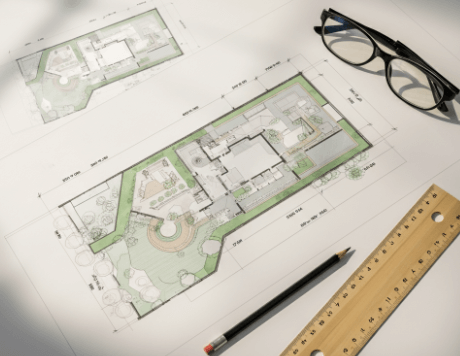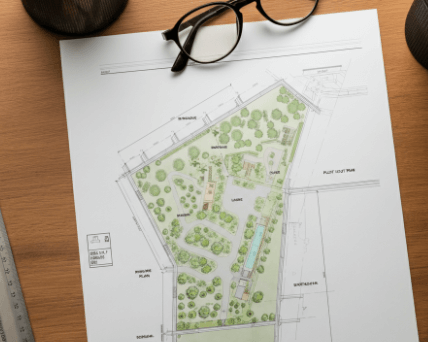Starting any real estate venture necessitates a clear and detailed understanding of the land. This is where a Plot Plan in Real Estate becomes invaluable. A Plot Plan in Real Estate is a comprehensive map that outlines a property’s boundaries, structures, and key features. Whether you’re a homeowner looking to build an extension, a developer planning a new project, or a buyer assessing potential properties, understanding the intricacies of a Plot Plan can provide crucial insights and help ensure your investment is sound. This blog will delve into what a Plot Plan entails and how it plays a vital role in the real estate process.
Real estate investors like Steve Daria and Joleigh have long recognized the importance of a Plot Plan in their ventures. By meticulously examining these detailed maps, they ensure their development projects proceed without legal or structural issues. Understanding Plot Plans allows them to make informed decisions, ultimately safeguarding and enhancing their investments.
What is a Plot Plan in Real Estate?
A plot plan in real estate, also known as a site plan, is a comprehensive drawing that outlines the layout and features of a piece of land.
It provides valuable information about property boundaries, existing structures, and proposed improvements such as buildings, driveways or shared driveway, and parking areas.
Essentially, a plot plan offers a bird’s-eye view of a property, aiding potential buyers, developers, and planners to understand its layout and possible uses.

The Legal and Technical Premises of a Plot Plan
A plot plan in real estate offers a more detailed and comprehensive view of a property’s configuration and features than a standard survey.
It is commonly used in zoning applications, construction permits, and property development projects to ensure compliance with municipal regulations and codes.
A plot plan accurately depicts property lines, structures, and neighboring plots, making it a vital tool for navigating the legal and technical aspects of real estate transactions and development processes.
Why is it Crucial for Real Estate Development and Transactions?
The importance of plot plans transcends various aspects of real estate activity.
For property developers, plot plans serve as a blueprint for spatial organization and development process planning.
Homebuyers rely on plot plans to understand property layouts and assess future modification possibilities while ensuring compliance with zoning regulations.
A thorough understanding of plot plans facilitates transparent and successful real estate transactions while mitigating potential legal and regulatory challenges.
Get An Offer Today, Sell In A Matter Of Days…
Creating a Plot Plan for Your Property
Developing a comprehensive plot plan requires careful planning and professional expertise. Here are the essential steps to create a detailed plot plan for your property:
Engage a Professional Land Surveyor
Consult a skilled land surveyor familiar with local zoning laws and land development regulations.
Gather Existing Documents
Collect any legal or technical documents associated with the property that will provide valuable information to the surveyor.
Draw to Scale and Include All Necessary Elements
Ensure the plot plan is drawn to scale, incorporating accurate measurements and all relevant land features per local regulations.
Comply with Zoning and Land Use Regulations
Ensure the plot plan aligns with zoning and land use regulations to avoid future fines and legal issues.
Understanding the Key Components of a Plot Plan in Real Estate
A comprehensive plot plan consists of several key components, each essential for understanding the layout and features of a property:
Property Lines and Dimensions
Outline the legal property boundaries and provide information about available space for development or modification.
Existing and Proposed Structures
Identify existing structures and proposed improvements, helping to visualize potential development projects and compliance with regulations.
Easements and Rights-of-Way
Highlight any easements or rights-of-way affecting the property that can impact current or future land use.
Topographic Information
Provide insight into the land’s slope and elevation, which is crucial for drainage and grading plans during development.
Utilizing a Plot Plan in Real Estate Endeavors
A comprehensive plot plan can be leveraged in various ways to support real estate endeavors:
Listing a Property with a Detailed Plot Plan
Provide detailed plot plans that showcase the property’s layout and potential uses to attract potential buyers or developers.
Navigating Zoning and Permit Processes
Facilitate the permitting process by providing accurate plot plans demonstrating compliance with zoning laws and regulations.
Facilitating Transparent Real Estate Transactions
Enhance transparency in real estate transactions by preemptively addressing potential disputes and alleviating buyer concerns with detailed plot plans.
Supporting the Development and Design Process
This role is the foundation for design and development projects, ensuring compliance with regulatory and environmental considerations.
Going Digital with Plot Plans
In the digital age, plot plans have evolved from static documents to dynamic data sets, offering enhanced functionality and accessibility:
Geographic Information Systems (GIS) Integration
Integrate plot plans into GIS systems to combine geographic and property-specific data, providing valuable insights into soil types, environmental factors, and regional assets.
Interactive and 3D Representations
Transform plot plans into interactive models that offer realistic visualizations of the property, aiding potential buyers in understanding its possible uses and features.
Pitfalls and Best Practices Around Plot Plans
While plot plans offer invaluable insights, it’s essential to be mindful of potential pitfalls and best practices:
Accuracy and Up-to-date Information
Update plot plans regularly to ensure accuracy and avoid costly errors resulting from outdated information.
Understanding and Negotiating Easements
Acknowledge existing easements on plot plans and negotiate their terms to mitigate potential land use restrictions.
Cross-referencing with Other Property Documents
Compare plot plans with other property documents to ensure completeness and accuracy.
Professional Review
Seek professional review from surveyors or real estate experts to verify the precision and dependability of plot layouts, minimizing the risk of oversight or discrepancies.

FAQs on A Plot Plan in Real Estate
This section addresses common questions and crucial information about plot plans in the real estate industry.
What is the difference between a plot plan and a survey?
A plot plan is a detailed blueprint of a piece of land that outlines its features, boundaries, and structures, while a survey is a more general measurement of land boundaries and legal descriptions.
Why must a professional land surveyor be engaged to create a plot plan?
Professional land surveyors have the expertise to accurately measure and document property boundaries, ensuring that the plot plan complies with local zoning laws and regulations.
How can plot plans be used in real estate transactions?
Plot plans can facilitate transparent real estate transactions by providing comprehensive visual representations of properties, preemptively addressing potential disputes, and ensuring compliance with zoning and permit requirements.
What role do plot plans play in property development projects?
Plot plans serve as blueprints for property development projects, guiding spatial organization, design, and construction processes while ensuring compliance with regulatory and environmental considerations.
Conclusion
A plot plan in real estate serves as an invaluable tool in real estate, offering comprehensive insights into property layouts, boundaries, and features. Whether you’re a property developer, homeowner, or real estate professional, understanding plot plans is essential for making informed decisions and navigating regulatory complexities.
By following best practices, leveraging digital advancements, and seeking professional assistance, you can harness the power of plot plans to unlock the full potential of your real estate endeavors. Remember, a well-executed plot plan is more than just a blueprint – it’s a strategic asset that can guide you toward success in the dynamic landscape of real estate.
**NOTICE: Please note that the content presented in this post is intended solely for informational and educational purposes. It should not be construed as legal or financial advice or relied upon as a replacement for consultation with a qualified attorney or CPA. For specific guidance on legal or financial matters, readers are encouraged to seek professional assistance from an attorney, CPA, or other appropriate professional regarding the subject matter.

